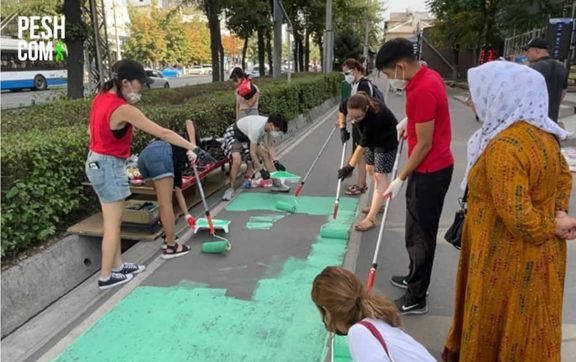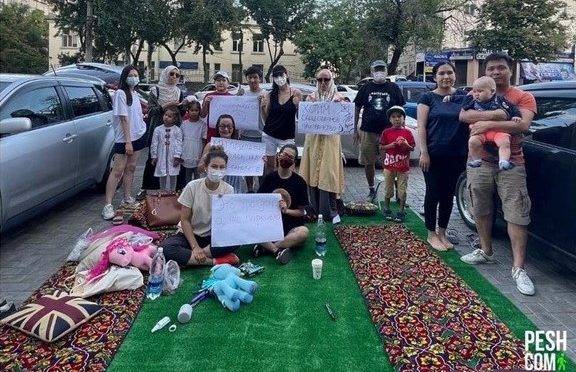In recent years, more activists have appeared in large cities of the countries of the region who are not indifferent to the fate of their place of residence. However, the majority of citizens remain passive, and this is the weakest spot in conflicts with the authorities and influential groups, activists say.

The activists of the megalopolises of the Central Asian countries have become much more actively involved in solving the problems of their cities, but the very development of urban activism is still in its infancy, experts say.
The growth of urbanization in Central Asia leads to an increase in such problems as the environmental and infrastructure degradation in cities, and poor quality of utilities. These problems are the same for almost all growing metropolitan areas in the region.
A regular expert meeting of the analytical platform CABAR.asia was devoted to the development of urban activism in Central Asian countries. The moderator was the editor Lola Olimova.
Social media moved forward the development of urban activism
In the countries of the region, since the earliest times and during the Soviet period, there were traditions of the participation of residents in solving the problems of their place of living. At the level of micro districts, “makhallas” and blocks, city residents jointly cleaned streets and ditches, planted trees, and laid out flower-beds.
But urban activism in Central Asia gained major development due to the spread of the Internet. Especially thanks to the development of social networks.

In Kazakhstan, the most proactive are residents of the city of Almaty, says Saltanat Tashimova, a blogger and city activist from that city and one of the founders of the «Zashchitim Alma-Atu/Almaty!» (Let’s Protect Almaty!) Facebook group. They mobilize quickly and “go out on their shields” in front of cranes to protect historic buildings or trees in their neighborhoods, but residents often remain passive when dealing with bigger city problems.
“Our activism is still in its infancy. At the same time, unambiguously, everyone began to understand that problems need to be solved systematically. There are an increasing number of citizens who are ready to participate in the lawmaking process,” Tashimova said.

Not everything can be done by the authorities. Much depends on the residents themselves. The same situation is in Bishkek, said Rada Valentina-kyzy, a city researcher and activist from Kyrgyzstan, founder of the «Peshcom» (By foot) movement in Bishkek. Despite the fact that Bishkek is the most active city in Kyrgyzstan, and many organizations of the non-governmental sector operate here, in general, residents are passive and believe that everything should be resolved by the municipal authorities.
“The overwhelming majority believe that everything in the city should be done by the mayor’s office or the deputies of the BCC (Bishkek City Council). At the same time, elections to the BCC were held recently, and the voter turnout was very low. Now we are working to attract citizens and explain to them that everything can not be done by the municipal authorities. Much depends on the citizens themselves,” she said.
Rada Valentina-kyzy noted with regret that with the new president in Kyrgyzstan, laws are being initiated to narrow the scope of activities of civic activists – in most cases, initiators of civic activism are NGOs. (Read more about it here).
“People can quickly get around to strike when an emergency arises, such as cutting down trees. But we would like Bishkek residents to have more personal activism,” said Rada.

In Dushanbe, the capital of Tajikistan, urban activism has increased markedly with the development of social networks, said Gulnora Amirshoeva, an expert from the Tajik capital, the founder of the group «YA – dushanbinets» (I am Dushanbenian) on Facebook, who is also the founder and editor-in-chief of the city newspaper «Vechorka».
“The rapid development of social networks contributed to the fact that indigenous Dushanbe residents began to unite together to implement initiatives to preserve the historical heritage in their city. However, all appeals and petitions of the townspeople, unfortunately, were not heard by the city authorities,” she said.

Urban activism in Uzbekistan was in the habitudes of the Uzbek people, said activist from Tashkent, Lola Islamova, founder and editor-in-chief of information agency Anhor.uz. Now, due to pandemic restrictions, it is impossible to gather in groups of more than 100 people. Therefore, activism has moved to the Internet, to social networks.
“We are witnessing the activity of citizens, very similar to neighboring countries, to save trees and buildings. In the traditions of the Uzbek people, there are so-called “hashars”, when people gather in makhallas and jointly build canals, clean the streets,” she says. – If we talk about some new undertakings, in addition to the traditional hashars for the improvement of the city, then people are cautious, bearing in mind the restrictive measures. Therefore, urban activism is more visible in social networks.”
Saving historic buildings and fighting against harassment on the city streets
The new realities in which the residents of the megalopolises of Central Asia live, despite the obstacles, nevertheless lead to the fact that more and more active city-folk unite and successfully implement projects that contribute to the improvement of their lives.
For example, in early July of this year, city activists regained the pedestrian zone near the Central Department Store in the center of Bishkek, which was occupied for the car parking.

Rada Valentina-kyzy, who was the initiator of the movement “Peshkom – a city for pedestrians”, said that the townspeople are gradually getting involved in the work to improve the urban environment. And if at first it was unusual for Bishkek residents to see carpets spread among cars and picnics in the center of the city, now more and more citizens understand that a lot in the life of their city depends on them too.
Other participants in the discussion session also spoke about positive examples of urban activism.
In Tashkent this year, city residents, thanks to their active position, prevented the installation of a stele and cutting down trees in the park near the Central Department Store in the center of Tashkent, said Lola Islamova.
In addition, city dwellers defend small squares in their neighborhoods and some historic buildings in disputes with developers. People making ado on social media and mobilizing quickly. Also, Tashkent residents are actively involved in collecting garbage both in the city and in the recreation areas of citizens outside the city.
The active movement of not indifferent residents of Almaty contributed to the fact that the city authorities adopted a resolution on the preservation of the historical center of the metropolis. Now, even if the ramshackle buildings in the center are being demolished, new buildings are being built in accordance with historical traditions.
In addition, residents influence unnecessary reconstruction of city streets and parks, defend the territory of stadiums and parks, and stop major construction projects that worsen the city infrastructure.
More and more caring people of Almaty, lawyers who confront developers and city authorities, are joining this urban movement. But since this confrontation is of a non-political nature, therefore, the authorities do not exert much pressure on the activists.
In Tajikistan, urban activists have failed to defend the historic center in the capital. Despite strong resistance, requests and petitions from citizens, the authorities began to implement the general plan for the reconstruction of the city in 2015, and many buildings dear to the hearts of Dushanbe residents were demolished.
Nevertheless, urban activism has prime examples when residents united and seeked to defend their rights. For example, in 2018, a movement against harassment on the streets of Dushanbe emerged on the pages of a social network on Facebook, when girls and women began to actively write and post about situations with harassment of men on the streets. Then this movement was supported by the mayor of the city, and now the police strictly monitor the behavior of boys and men relatively to girls and women on the streets of Dushanbe.
In addition, residents of the Tajik capital also get around to clean up garbage from various territories and to plant trees. There are other examples when activists are trying to seek from the city authorities to solve their problems.
Cooperation between city administrations, business structures and city activists
While in Western European countries, city authorities, business and city activists work closely together and jointly solve problems in their city, in the capitals of Central Asian countries, the relationship between these three structures is not always so perfect.
City authorities support activists’ initiatives only if it does not contradict their interests. Business structures rarely support activists, providing them with scanty financial assistance, also only in those cases when it is beneficial for them, experts noted.
Rada Valentina-kyzy believes that businessmen are not interested in promoting urban initiatives if it does not benefit them.

Saltanat Tashimova stated that there are active businessmen in Almaty, but, unfortunately, there are very few of them. Basically, these are businesswomen who are ready to invest their money and time, share their thoughts and experiences.
Gulnora Amirshoeva said that businessmen in Dushanbe also help activists, but such occasions are few.
Most businessmen help at the request of the mayor’s office.
“As a former deputy of the city council, I know how many businessmen are helping at the request of the city authorities for the construction of roads, improvement of the city and other large investments. Although they don’t always like it, they have no choice, but to do it,” she said.
In Tashkent, when the mayor’s office initiates projects, such as planting trees, landscaping, cleaning, then businessmen support these projects. In these cases, city activists are also supported by pro-government NGOs, such as the Youth Association, Lola Islamova noted.
In all other cases, businessmen are reluctant to support urban activists’ initiatives, as there are no benefits for them.
“Business corporations need media coverage of their activities, they want the press to mention that the action was financially supported by them. In such cases, the media demand payment for advertising, although this is not advertisment information,” she said.
Urban activists of megalopolises called on all residents of Central Asia to become more actively involved in improving the living environment in their cities and not to remain indifferent to their social problems.

